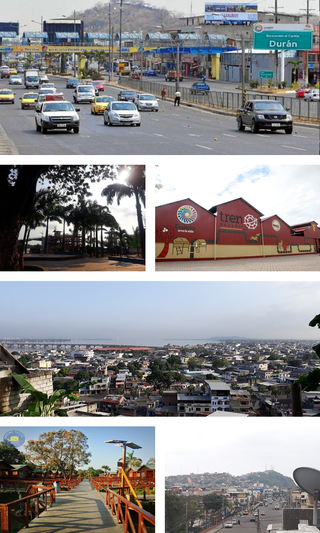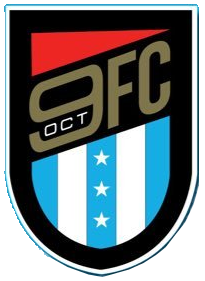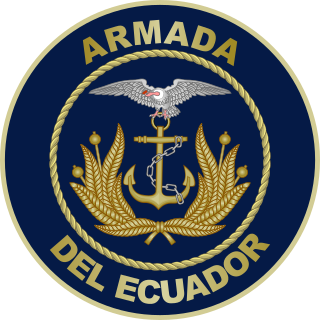Related Research Articles

Guayaquil, officially Santiago de Guayaquil, is the second largest city in Ecuador and also the nation's economic capital and main port. The city is the capital of Guayas Province and the seat of Guayaquil Canton. The city is located on the west bank of the Guayas River, which flows into the Pacific Ocean at the Gulf of Guayaquil.

Guayas is a coastal province in Ecuador. It is bordered to the west by Manabí, Santa Elena, and the Pacific Ocean ; to the east by Los Ríos, Bolívar, Chimborazo, Cañar, and Azuay; to the north by Los Ríos and Bolívar; and to the south by El Oro and the Pacific Ocean.

The gunwale is the top edge of the hull of a ship or boat.
"Down East", also "Downeast", is a term for parts of eastern coastal New England and Canada, particularly the U.S. state of Maine and Canada's Maritime Provinces, an area that closely corresponds to the historical French territory of Acadia. The phrase apparently derives from sailing terminology: sailors from western ports sailed downwind toward the east to reach the area.

In sewing and haberdashery, notions are small objects or accessories, including items that are sewn or otherwise attached to a finished article, such as buttons, snaps, and collar stays. Notions also include the small tools used in sewing, such as needles, thread, pins, marking pens, elastic, and seam rippers. The noun is almost always used in the plural. The term is chiefly in American English. It was also formerly used in the phrase "Yankee notions", meaning American products. A fabric store will have a section or department devoted to notions, and a spool of thread is considered a notion.

The Guayas River also called Rio Guayas is a major river in western Ecuador. It gives name to Guayas Province and is the most important river in South America that does not flow into the Atlantic Ocean or any of its marginal seas. Its total length, including the Daule River, is 389 km (241 mi). The Guayas River's drainage basin is 34,500 km2 and it has an average discharge of 70,000 cu ft/s. It is the national river of Ecuador and is present on the Coat of Arms.

Durán, is a canton located in the province of Guayas, Ecuador, near the confluence of the Daule & Babahoyo rivers, where the Guayas River enters the ocean. It is located across the Guayas River from Guayaquil. Its township or capital is Eloy Alfaro. The canton was created in 1986 during the presidential period of Leon Febres Cordero through a presidential decree. The name "Eloy Alfaro" was chosen because of the Ecuadorian ex-president Eloy Alfaro Delgado. According to the National census in 2010, there are 235,769 people residing within the canton limits. Many of its inhabitants commute to other places for work and it can be considered a "dormitory town". However, many people who live in Durán find work within the canton by opening "comedores" or small restaurants, selling produce at the market, or even opening little stores with basic produce and house necessities. The towns Durán, Samborondón, and Guayaquil are connected by the bridge Rafael Mendoza Avilés.

The Guayaquil Canton, officially the Municipality of Guayaquil, is a canton in the center of the Guayas Province in western Ecuador. The canton was named after its seat, the city of Guayaquil, the most populous city in Ecuador.
Guayas may refer to:

Babahoyo, founded May 27, 1948, by legislative decree, is the capital of the Los Ríos province of Ecuador. Its population is cited around 153,000. It is bordered by two rivers, the San Pablo and the Caracol, which join to form the Babahoyo River. This meets the Daule River to form the Guayas River, which runs to the Pacific Ocean at the Gulf of Guayaquil.

9 de Octubre Fútbol Club, simply referred to as Nueve (9) de Octubre, is a sports club based in Guayaquil, Ecuador. The club is best known for its football team.

Pre-Columbian Ecuador included numerous indigenous cultures, who thrived for thousands of years before the ascent of the Incan Empire. Las Vegas culture of coastal Ecuador, flourishing between 8000 and 4600 BC, is one of the oldest cultures in the Americas. The subsequent Valdivia culture in the Pacific coast region is another well-known early Ecuadorian culture. Ancient Valdivian artifacts from as early as 3500 BC have been found along the coast north of the Guayas Province in the modern city of Santa Elena.

Guayas is a sail training ship of the Ecuadorian Navy. Launched in 1976, it was named in jointly in honor of Chief Guayas, the Guayas river, and Guayas, the first steamship that was constructed in South America in 1841, and is displayed on the Ecuadorian coat of arms. The ship's home base is Guayaquil, Ecuador.

The Battle of Guayaquil was the final and pivotal armed confrontation in a struggle for political control of Ecuador. The battle was fought on the outskirts of the city of Guayaquil, Ecuador on September 22–24, 1860, among several factions claiming control of the country in the wake of the abdication of president Francisco Robles, amidst continuous Peruvian military pressure due to the ongoing Ecuadorian–Peruvian territorial dispute. The battle brought an end to a series of skirmishes between the forces of Gabriel García Moreno's Provisional Government, backed by General Juan José Flores, and the government of General Guillermo Franco in Guayas, which was recognized by Peruvian president Ramón Castilla.

Palestina is a town located in northern Guayas, Ecuador. It is the seat of Palestina Canton, created in 1988. Palestina currently has 16,065 inhabitants, and its nearby cities are Santa Lucía, Daule, Colimes and Balzar. This town is located 80 km from Guayaquil, at the Northern Centre of the province; in other words, it is located 75 km from the capital province. This town occupies a territory of approximately 300 km2.

Pedro Carbo Canton is a land-locked coastal canton located in Guayas Province in Ecuador, near Manabí Province. Its capital is the town of Pedro Carbo. It is located at the 63 kilometer marker on the road from Guayaquil to Manabí. It is the seat of Pedro Carbo Cantón, founded in 1984. As of the census of 2001, there are 36,711 people residing within canton limits. A new census was conducted in 2010 but results are yet unknown. The city is named after Pedro Carbo Noboa, a 19th-century politician, diplomat and writer from Guayaquil.

The Manteño-Huancavilca culture were one of the last pre-Columbian cultures in modern-day Ecuador, active from 850 to 1600 CE. It encompasses the area of the earlier Valdivia culture.

The Ecuadorian Navy is an Ecuadorian entity responsible for the surveillance and protection of national maritime territory and has a personnel of 9,400 men to protect a coastline of 2,237 km which reaches far into the Pacific Ocean. The vessels are identified by a ship prefix of B.A.E.: Buque de la Armada del Ecuador or L.A.E.: Lancha de la Armada del Ecuador.
Cañari and Puruhá are two poorly-attested extinct languages of the Marañón River basin in Ecuador that are difficult to classify. Puruhá is scarcely attested, and Cañari is known primarily from placenames. Loukotka (1968) suggests they may have been related instead to Mochica (Yunga) in a family called Chimuan, but Adelaar (2004:397) thinks it is more likely that they were Barbacoan languages.

Marcel Jacobo Laniado de Wind was an Ecuadorian agricultural engineer and banker who held a number of important public and private positions in Ecuador. He was a humanist, and a public figure in Ecuador for his efforts to improve the country.
References
- ↑ Hopkins (1997). Merriam-Webster's Geographical Dictionary. Merriam-Webster. p. 455. ISBN 9780877795469.
- ↑ Schäuffelen, Otmar (2005). Chapman Great Sailing Ships of the World. Hearst Books. ISBN 9781588163844.